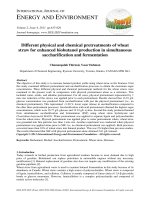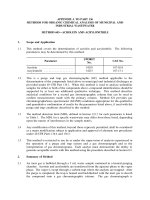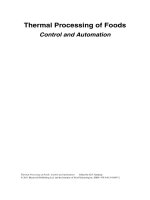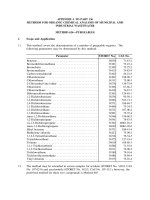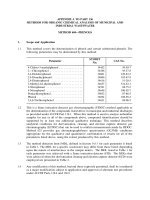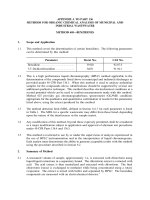chemical processing of ceramics
Bạn đang xem bản rút gọn của tài liệu. Xem và tải ngay bản đầy đủ của tài liệu tại đây (24.38 MB, 737 trang )
Chemical
Processing
of Ceramics
Second Edition
© 2005 by Taylor & Francis Group, LLC
MATERIALS ENGINEERING
1. Modern Ceramic Engineering: Properties, Processing,
and Use in Design. Second Edition, Revised
and Expanded,
David W. Richerson
2. Introduction to Engineering Materials: Behavior,
Properties, and Selection,
G. T. Murray
3. Rapidly Solidified Alloys: Processes • Structures •
Applications,
edited by Howard H. Liebermann
4. Fiber and Whisker Reinforced Ceramics for Structural
Applications,
David Belitskus
5. Thermal Analysis of Ceramics,
Robert F. Speyer
6. Friction and Wear of Ceramics,
edited by
Said Jahanmir
7. Mechanical Properties of Metallic Composites,
edited
by Shojiro Ochiai
8. Chemical Processing of Ceramics,
edited by
Burtrand I. Lee and Edward J. A. Pope
9. Handbook of Advanced Materials Testing,
edited by
Nicholas P. Cheremisinoff and Paul N. Cheremisinoff
10. Ceramic Processing and Sintering,
M. N. Rahaman
11. Composites Engineering Handbook,
edited by
P. K. Mallick
12. Porosity of Ceramics,
Roy W. Rice
13. Intermetallic and Ceramic Coatings,
edited by
Narendra B. Dahotre and T. S. Sudarshan
14. Adhesion Promotion Techniques: Technological
Applications,
edited by K. L. Mittal and A. Pizzi
15. Impurities in Engineering Materials: Impact, Reliability,
and Control,
edited by Clyde L. Briant
16. Ferroelectric Devices,
Kenji Uchino
17. Mechanical Properties of Ceramics and Composites:
Grain and Particle Effects,
Roy W. Rice
18. Solid Lubrication Fundamentals and Applications,
Kazuhisa Miyoshi
19. Modeling for Casting and Solidification Processing,
edited by Kuang-O (Oscar) Yu
20. Ceramic Fabrication Technology,
Roy W. Rice
21. Coatings of Polymers and Plastics,
edited by
Rose A. Ryntz and Philip V. Yaneff
© 2005 by Taylor & Francis Group, LLC
22. MicroMechatronics,
edited by Kenji Uchino
and Jayne Giniewicz
23. Ceramic Processing and Sintering, Second Edition,
edited by M. N. Rahaman
24. Handbook of Metallurgical Process Design,
edited by
George Totten
25. Ceramic Materials for Electronics, Third Edition,
Relva Buchanan
26. Physical Metallurgy,
William F. Hosford
27. Carbon Fibers and Their Composites,
Peter Morgan
28. Chemical Processing of Ceramics: Second Edition,
Burtrand Lee and Sridhar Komarneni
© 2005 by Taylor & Francis Group, LLC
Chemical
Processing
of Ceramics
Second Edition
edited by
Burtrand Lee
Sridhar Komarneni
Boca Raton London New York Singapore
A CRC title, part of the Taylor & Francis imprint, a member of the
Taylor & Francis Group, the academic division of T&F Informa plc.
© 2005 by Taylor & Francis Group, LLC
Published in 2005 by
CRC Press
Taylor & Francis Group
6000 Broken Sound Parkway NW, Suite 300
Boca Raton, FL 33487-2742
© 2005 by Taylor & Francis Group, LLC
CRC Press is an imprint of Taylor & Francis Group
No claim to original U.S. Government works
Printed in the United States of America on acid-free paper
10 987654321
International Standard Book Number-10: 1-57444-648-7 (Hardcover)
International Standard Book Number-13: 978-1-57444-648-7 (Hardcover)
Library of Congress Card Number 2004065504
This book contains information obtained from authentic and highly regarded sources. Reprinted material is
quoted with permission, and sources are indicated. A wide variety of references are listed. Reasonable efforts
have been made to publish reliable data and information, but the author and the publisher cannot assume
responsibility for the validity of all materials or for the consequences of their use.
No part of this book may be reprinted, reproduced, transmitted, or utilized in any form by any electronic,
mechanical, or other means, now known or hereafter invented, including photocopying, microfilming, and
recording, or in any information storage or retrieval system, without written permission from the publishers.
For permission to photocopy or use material electronically from this work, please access www.copyright.com
Danvers, MA 01923, 978-750-8400. CCC is a not-for-profit organization that provides licenses and registration
for a variety of users. For organizations that have been granted a photocopy license by the CCC, a separate
system of payment has been arranged.
Trademark Notice: Product or corporate names may be trademarks or registered trademarks, and are used only
for identification and explanation without intent to infringe.
Library of Congress Cataloging-in-Publication Data
Chemical processing of ceramics.–2nd ed. / edited by Burtrand Lee and Sridhar Komarneni.
p. cm.– (Materials engineering ; 28)
Includes bibliographical references and index.
ISBN 1-57444-648-7 (alk. paper)
1. Ceramics–Analysis. 2. Ceramic materials. I. Lee, Burtrand Insung. II. Komarneni,
Sridhar. III. Title. IV. Series: Materials engineering (Marcel Dekker, Inc.) ; 28.
TP810.5.C48 2005
666–dc22 2004065504
Visit the Taylor & Francis Web site at
and the CRC Press Web site at
Taylor & Francis Group
is the Academic Division of T&F Informa plc.
© 2005 by Taylor & Francis Group, LLC
( or contact the Copyright Clearance Center, Inc. (CCC) 222 Rosewood Drive,
Foreword
The progress of civilization is often marked by naming ages, for example, the
Stone Age, the Bronze Age, the Iron Age, the Steel Age. We are at the threshold
of change from the Silicon or Information Age to the Age of Biology. A vital
question is “What is the role of ceramics in an age of biology?” It is a challenging
question and the future growth of the ceramics industry may well depend on how
cleverly we approach the needs of the biological revolution and an aging popu-
lation. Large segments of the population will need replacement parts before death.
Can ceramics provide the additional survivability of these prostheses? Can bio-
active ceramics with controlled release of ions and growth factors be used to turn
on the body’s own regenerative potential? We are also at the threshold of a change
from an energy-rich society to an energy-declining society. How will ceramics
help industry respond to this need? Can we create recyclable ceramic products
that are affordable? Can we make products with substantially lower power
requirements? Again, these questions are difficult, but the creativity of our
responses may determine the quality of life for the new age.
This new edition of Chemical Processing of Ceramics offers a scientific and
technological framework for achieving creative solutions to the questions posed
above. It has been 20 years since the first Ultrastructure and Chemical Processing
Conference proceedings were published. Enormous progress has been made in
understanding the process mechanisms for chemical-based processing of new
materials. The theoretical foundations are now well established and are being
applied to an expanding range of materials. New process methods are being
discovered. These new developments are all discussed in this new edition. The
editors have made thoughtful selections from the leading researchers in the field.
Their success makes this book a must for every serious investigator in the field
of ceramic processing.
Larry L. Hench
Professor of Ceramic Materials
Imperial College, London
© 2005 by Taylor & Francis Group, LLC
Preface
Despite many recent advances in materials science and engineering, the perfor-
mance of ceramic components in severe conditions is still far below the ideal
limits predicted by theory. The emphasis on the relation between processing,
structure, and behavior has been fruitful for ceramic scientists for several decades.
It has been recently realized, however, that major advances in ceramics during
the next several decades will require an emphasis on molecular-level or nanoscale
control. Organic chemistry, once abhorred by ceramic engineers trained to define
ceramics as “inorganic-nonmetallic materials,” has become a valuable asset in
designing and synthesizing new ceramics. It has recently been established that
as the structural scale in ceramics is reduced from macro- to micro- to nanocrys-
talline regimes, the basic properties are drastically altered. Some brittle ceramic
materials have been shown to be partially ductile. Quantum dot semiconducting
ceramic particles emit different colors, depending on their size, and this property
can be useful in various applications.
The impetus and the ultimate goal in chemical processing of ceramic materials
is to control physical and chemical variability by the assemblage of uniquely
homogeneous structures, nanosized second phases, controlled surface composi-
tional gradients, and unique combinations of dissimilar materials to achieve
desired properties. Significant improvements in environmental stability and per-
formance should result from such nanoscale or molecular design of materials.
A number of books are available that deal with the chemical processing aspect
of ceramic materials, but most of them are conference proceedings. This revised
edition of Chemical Processing of Ceramics is written to update, enhance, and
expand the topics in the first edition published in 1994. Many authors who are
actively involved in the field of chemical processing of ceramic materials from
all over the world contributed to the first edition. The authors in this edition are
also from the international community—Australia, Japan, Germany, Korea,
France, Russia, Switzerland, and the U.S.—practicing chemical principles in the
fabrication of superior ceramic materials.
Thus this book presents current developments and concepts in the chemical
techniques for production and characterization of state-of-the-art ceramic mate-
rials in a truly interdisciplinary fashion. The 27 chapters are divided into five
parts reflecting topical groups. The first part discusses the starting materials—how
to prepare and modify them in the nanoscale range. Powders are the most heavily
used form of starting ceramic materials. The synthesis, characterization, and
behavior of ceramic powders are presented in parts I and II. In the third part,
processing of ceramic films via the sol-gel technique is discussed. Fabrication of
© 2005 by Taylor & Francis Group, LLC
nonoxide ceramics is covered in part IV. In the last part, several specific examples
of classes of ceramic materials fabricated by chemical processing, including thin
films, membranes, ferroelectrics, bioceramics, dielectrics, batteries, and super-
conductors, are presented. These classes of examples are chosen on the basis of
the current demand and active research. The topics on basic principles of the sol-
gel technique, sintering, and postsintering processes are not included in this
volume because there are other excellent books dealing solely with these topics.
Although this book is edited, it is organized to reflect the sequence of ceramics
processing and the coherent theme of chemical processing for advanced ceramic
materials. Hence this book is suitable as a supplementary textbook for advanced
undergraduate and graduate courses in ceramic science and materials chemistry,
as well as an excellent reference book for practicing ceramists, chemists, materials
scientists, and engineers. As shown by the data presented in this book, some of
the interesting results from chemical processing have not yet made their way into
real applications of ceramic materials. We are optimistic that, through further
research, the full potential of chemical processing for high-performance ceramic
materials can be realized. It is hoped that this book, through the authors’ and
editors’ contributions, will bring researchers and engineers in the ceramics and
chemical fields closer together to produce superior ceramic materials.
Burtrand I. Lee
Sridhar Komarneni
© 2005 by Taylor & Francis Group, LLC
Editors
Burtrand Insung Lee, Ph.D. is a professor in
the School of Materials Science & Engineering
at Clemson University, Clemson, South Caro-
lina. He obtained his B.S. degree in chemistry
from Southern Adventist University, Tennes-
see, and Ph.D. degree in materials science and
engineering from the University of Florida,
Gainesville, Florida in 1986. His industrial
working experience includes Biospherics Inc.,
Gel Tech Inc., Kemet Electronics Materials
Corp., Hitachi Ltd., and Samsung Electronics.
Dr. Lee was a Fulbright Professor at Nor-
wegian Institute of Technology in Norway in
1989. In 1993 he spent a sabbatical year at
Hitachi Research Laboratory as a senior visiting researcher. He has published
over 170 technical papers and other books on ceramic and polymer processing
as well as several U.S. patents. He has co-organized many national/international
technical symposia on materials and nano-processing. Dr. Lee received the MRS
Award in 1986, Fulbright Scholar Award in 1989, Clemson Board of Trustee
Faculty Excellence Awards in 2001 and 2004, and he was selected as a Lady
Davis Fellow in 2004.
Dr. Lee teaches colloidal and surface science as well as general materials
processing at Clemson University. He is also director of Nanofabritech
®
. His current
research activities are focused on chemical processing of ceramic and polymeric
materials, paying particular attention to surface and interfacial chemistry.
© 2005 by Taylor & Francis Group, LLC
Sridhar Komarneni, Ph.D. is a professor of
clay mineralogy at The Pennsylvania State
University, University Park, Pennsylvania.
He conducts research on synthesis and pro-
cessing of nanophases and nanocomposites
by sol-gel and hydrothermal processing and
on both basic and applied aspects of clay
minerals. He has published over 415 refereed
papers and edited or written 13 books during
his career and received numerous awards. Dr.
Komarneni was elected to The World Acad-
emy of Ceramics, The European Academy of
Sciences and Fellows of The American Asso-
ciation for the Advancement of Science, The
Royal Society of Chemistry, The American Society of Agronomy, The Soil
Science Society of America, and The American Ceramic Society. He serves as
the editor-in-chief of Journal of Porous Materials.
© 2005 by Taylor & Francis Group, LLC
Contributors
André Ayral
Universite Montpellier II
Montpellier, France
Prerak Badheka
Clemson University
Clemson, South Carolina
John Ballato
Clemson University
Clemson, South Carolina
Dunbar P. Birnie, III
Rutgers University
Piscataway, New Jersey
Guozhong Cao
University of Washington
Seattle, Washington
Jin-Ho Choy
Ewha Womans University
Seoul, Korea
Philippe Colomban
CNRS and Université P.
& M. Curie (Paris 6)
Thiais, France
Amit Daga
University of Florida
Gainesville, Florida
Moni K. Datta
Carnegie Mellon University
Pittsburgh, Pennsylvania
Deepa Dey
Tokyo Institute of Technology
Yokohama, Japan
Jeffrey DiMaio
Clemson University
Clemson, South Carolina
Harold Dobberstein
University of Cambridge
Cambridge, England
Aaron C. Dodd
University of Western Australia
Crawley, Australia
Toshiya Doi
Kagoshima University
Kagoshima, Japan
Eric Forsythe
Army Research Lab
Adelphi, Maryland
Christian Guizard
Universite Montpellier II
Montpellier, France
Masashi Inoue
Kyoto University
Kyoto, Japan
Anne Julbe
Universite Montpellier II
Montpellier, France
© 2005 by Taylor & Francis Group, LLC
Masato Kakihana
IMRAM, Tohoku University
Sendai, Japan
Hendrik K. Kammler
Swiss Federal Institute of Technology
Zurich, Switzerland
Takeo Katoh
Hanyang University
Seoul, South Korea
Masanori Kikuchi
National Institute for Materials
Science
Tsukuba, Japan
Eung Soo Kim
Kyonggi University
Suwon, South Korea
Il-Seok Kim
Carnegie Mellon University
Pittsburgh, Pennsylvania
Sang Kyun Kim
Hanyang University
Seoul, South Korea
Sridhar Komarneni
Pennsylvania State University
University Park, Pennsylvania
Prashant N. Kumta
Carnegie Mellon University
Pittsburgh, Pennsylvania
Burtrand I. Lee
Clemson University
Clemson, South Carolina
Lutz Mädler
Swiss Federal Institute of Technology
Zürich, Switzerland
Jeffrey P. Maranchi
Carnegie Mellon University
Pittsburgh, Pennsylvania
David Morton
Army Research Lab
Adelphi, Maryland
Masaki Narisawa
Osaka Prefecture University
Osaka, Japan
Tomoji Ohishi
Shibaura Institute of Technology
Tokyo, Japan
Nickolay N. Oleynikov
Moscow State University
Moscow, Russia
Masataka Ozaki
Yokohama City University
Yokohama, Japan
Ungyu Paik
Hanyang University
Seoul, South Korea
Jea Gun Park
Hanyang University
Seoul, South Korea
Man Park
Kyungpook National University
Teagu, South Korea
Valery Petrykin
IMRAM, Tohoku University
Sendai, Japan
Georgios Pyrgiotakis
University of Florida
Gainesville, Florida
© 2005 by Taylor & Francis Group, LLC
Lai Qi
Clemson University
Clemson, South Carolina
Rustum Roy
Pennsylvania State University
University Park, Pennsylvania
Theodor Schneller
Institut fur Werkstoffe der
Elektrotechnik II
Aachen, Germany
Robert Schwartz
University of Missouri
Rolla, Missouri
Oleg A. Shlyakhtin
Moscow State University
Moscow, Russia
Wolfgang Sigmund
University of Florida
Gainesville, Florida
Shigeyuki Somiya
Tokyo Institute of Technology and
Teikyo University of Science and
Technology
Tokyo, Japan
Koji Tomita
IMRAM, Tohoku University
Sendai, Japan
Yuri D. Tretyakov
Moscow State University
Moscow, Russia
Oleg I. Velikokhatnyi
Carnegie Mellon University
Pittsburgh, Pennsylvania
Li-Qiong Wang
Pacific Northwest National
Laboratory
Richland, Washington
Xinyu Wang
University of Minnesota
Minneapolis, Minnesota
Ying Wang
University of Washington
Seattle, Washington
Rainer Waser
RWTH Aachen University of
Technology
Aachen, Germany
Markus Weinmann
Max-Planck-Institut fur
Metallforschung
Stuttgart, Germany
D.H. Yoon
Clemson University
Clemson, South Carolina
Ki Hyun Yoon
Yonsei University
Seoul, Korea
© 2005 by Taylor & Francis Group, LLC
Table of Contents
SECTION I Powder Synthesis and Characterization
Chapter 1 Hydrothermal Synthesis of Ceramic Oxide Powders 3
Shigeyuki Somiya, Rustum Roy, and Sridhar Komarneni
Chapter 2 Solvothermal Synthesis 21
Masashi Inoue
Chapter 3 Mechanochemical Synthesis of Ceramics 65
Aaron C. Dodd
Chapter 4 Cryochemical Synthesis of Materials 77
Oleg A. Shlyakhtin, Nickolay N. Oleynikov, and Yuri D. Tretyakov
Chapter 5 Environmentally Benign Approach to Synthesis of
Titanium-Based Oxides by Use of Water-Soluble Titanium
Complex 139
Koji Tomita, Deepa Dey, Valery Petrykin, and Masato Kakihana
Chapter 6 Peroxoniobium-Mediated Route toward the
Low-Temperature Synthesis of Alkali Metal Niobates
Free from Organics and Chlorides 161
Deepa Dey and Masato Kakihana
Chapter 7 Synthesis and Modification of Submicron Barium
Titanate Powders 173
Burtrand I. Lee, Xinyu Wang, D.H. Yoon, Prerak Badheka, Lai Qi,
and Li-Qiong Wang
Chapter 8 Magnetic Particles: Synthesis and Characterization 193
Masataka Ozaki
© 2005 by Taylor & Francis Group, LLC
Chapter 9 Synthesis and Surface Modification of Zinc Sulfide-Based
Phosphors 217
Lai Qi, Burtrand I. Lee, David Morton, and Eric Forsythe
Chapter 10 Characterization of Fine Dry Powders 233
Hendrik K. Kammler and Lutz Mädler
SECTION II Powder Processing at Nanoscale
Chapter 11 Theory and Applications of Colloidal Processing 269
Wolfgang Sigmund, Georgios Pyrgiotakis, and Amit Daga
Chapter 12 Nano/microstructure and Property Control of Single and
Multiphase Materials 303
Philippe Colomban
Chapter 13 Nanocomposite Materials 341
Sridhar Komarneni
Chapter 14 Molecular Engineering Route to Two Dimensional
Heterostructural Nanohybrid Materials 369
Jin-Ho Choy and Man Park
Chapter 15 Nanoceramic Particulates for Chemical Mechanical
Planarization in the Ultra Large Scale Integration
Fabrication Process 393
Ungyu Paik, Sang Kyun Kim, Takeo Katoh, and Jea Gun Park
SECTION III Sol-Gel Processing
Chapter 16 Chemical Control of Defect Formation During Spin-Coating
of Sol-Gels 411
Dunbar P. Birnie, III
© 2005 by Taylor & Francis Group, LLC
Chapter 17 Preparation and Properties of SiO
2
Thin Films by
the Sol-Gel Method Using Photoirradiation and Its
Application to Surface Coating for Display 421
Tomoji Ohishi
SECTION IV Ceramics Via Polymers
Chapter 18 Organosilicon Polymers as Precursors for Ceramics 439
Markus Weinmann
Chapter 19 Polymer Pyrolysis 491
Masaki Narisawa
SECTION V Processing of Specialty Ceramics
Chapter 20 Chemical Vapor Deposition of Ceramics 511
Guozhong Cao and Ying Wang
Chapter 21 Ceramic Photonic Crystals: Materials, Synthesis, and
Applications 543
Jeffrey DiMaio and John Ballato
Chapter 22 Tailoring Dielectric Properties of Perovskite Ceramics at
Microwave Frequencies 571
Eung Soo Kim, Ki Hyun Yoon, and Burtrand I. Lee
Chapter 23 Synthesis and Processing of High-Temperature
Superconductors 595
Toshiya Doi
Chapter 24 Synthesis of Bone-Like Hydroxyapatite/Collagen
Self-Organized Nanocomposites 613
Masanori Kikuchi
© 2005 by Taylor & Francis Group, LLC
Chapter 25 Ceramic Membrane Processing: New Approaches in
Design and Applications 629
André Ayral, Anne Julbe, and Christian Guizard
Chapter 26 Ceramic Materials for Lithium-Ion Battery Applications 667
Jeffrey P. Maranchi, Oleg I. Velikokhatnyi, Moni K. Datta, Il-Seok Kim,
and Prashant N. Kumta
Chapter 27 Chemical Solution Deposition of Ferroelectric Thin Films 713
Robert Schwartz, Theodor Schneller, Rainer Waser,
and Harold Dobberstein
© 2005 by Taylor & Francis Group, LLC
Section I
Powder Synthesis and
Characterization
© 2005 by Taylor & Francis Group, LLC
3
1
Hydrothermal Synthesis
of Ceramic Oxide
Powders*
Shigeyuki Somiya, Rustum Roy,
and Sridhar Komarneni
CONTENTS
I. Introduction 4
II. Hydrothermal Synthesis 5
A. Some Results in Different Categories (Hydrothermal
Decomposition) 7
1. Ilmenite 7
B. Hydrothermal Metal Oxidation 7
1. Zirconium Metal 7
2. Aluminum Metal 8
3. Titanium Metal 8
C. Hydrothermal Reactions 8
D. Hydrothermal Precipitation or Hydrothermal Hydrolysis 9
1. Alumina 9
2. Zirconia 11
E. Hydrothermal Electrochemical Method 11
F. Reactive Electrode Submerged Arc 14
G. Hydrothermal Mechanochemical Process 14
H. Microwave Hydrothermal Process 16
I. Hydrothermal Sonochemical Method 18
III. Ideal Powders and Real Powders 18
References 19
* Reproduced with permission from the Indian Academy of Sciences. This article was originally
published in the Bull. Mat. Sci., 23, 453–460 and the current version is slightly modified.
© 2005 by Taylor & Francis Group, LLC
4 Chemical Processing of Ceramics, Second Edition
I. INTRODUCTION
Inorganic powders play a key role in many fields—ceramics, catalysts, medicines,
food, etc.—and many papers and books discuss powder preparation.
1–5
Powder
preparation is a very important step in the processing of ceramics. Table 1.1
presents the methods used for preparing fine ceramic powders.
6
TABLE 1.1
Methods for Producing Fine Ceramic Powders
1. Mechanical
a. Ball milling (powder mixing)
b. Attrition milling
c. Vibration milling
2. Thermal decomposition
a. Heating (evaporation)
b. Spray drying
c. Flame spraying
d. Plasma spraying
e. Vapor phase (CVD)
f. Freeze-drying (cryochemical)
g. Hot kerosene drying
h. Hot petroleum drying
i. Combustion
j. Laser beam
k. Electron beam
l. Sputtering
3. Precipitation or hydrolysis
a. Neutralization and precipitation
b. Homogeneous precipitation
c. Coprecipitation
d. Salts solution
e. Alkoxides
f. Sol-gel
4. Hydrothermal
a. Precipitation (coprecipitation)
b. Crystallization
c. Decomposition
d. Oxidation
e. Synthesis
f. Electrochemical
g. Mechanochemical
h. Reactive electrode submerged arc (RESA)
i. Microwave
j. Ultrasonic
5. Melting and rapid quenching
© 2005 by Taylor & Francis Group, LLC
Hydrothermal Synthesis of Ceramic Oxide Powders 5
II. HYDROTHERMAL SYNTHESIS
The term hydrothermal comes from the earth sciences, where it implies a regime
of high temperatures and water pressures. Table 1.2 shows the types of hydro-
thermal synthesis.
7–18
The major differences between hydrothermal processing
and other technologies are shown in Table 1.3.
4,6,17,19
For typical hydrothermal
research one needs a high-temperature, high-pressure apparatus called an auto-
clave or bomb. A great deal of early experimental work was done using the
TABLE 1.2
Hydrothermal Synthesis
Hydrothermal crystal growth
Hydrothermal treatment
Hydrothermal alteration
Hydrothermal dehydration
Hydrothermal extraction
Hydrothermal reaction sintering
Hydrothermal sintering
Corrosion reaction
Hydrothermal oxidation
Hydrothermal precipitation—hydrothermal crystallization
Hydrothermal decomposition
Hydrothermal hydrolysis—hydrothermal precipitation
Hydrothermal electrochemical reaction
Hydrothermal mechanochemical reaction
Hydrothermal + ultrasonic
Hydrothermal + microwave
TABLE 1.3
Major Differences of Powders and Processing Between Hydrothermal
and Other Technologies for Powder Preparation
1. Powders are formed directly from solution.
2. Powders are anhydrous, crystalline, or amorphous depending on the hydrothermal temperature.
3. Particle size controlled by hydrothermal temperature.
4. Particle shape controlled by starting materials.
5. Ability to control chemical composition, stoichiometry, etc.
6. Powders are highly reactive in sintering.
7. In many cases, powders do not need calcination.
8. In many cases, powders do not need a milling process.
Based on studies mainly by W.J. Dawson, D. Segal, D.W. Johnson, and S. Somiya.
© 2005 by Taylor & Francis Group, LLC
6 Chemical Processing of Ceramics, Second Edition
Morey bomb
7
and Tuttle-Roy test tube bomb (made by Tem-Press), which are
both as a catalyst and occasionally as a component of solid phases in synthesis
at elevated temperatures (greater than 100°C) and pressures (more than a few
atmospheres). At present, one can get many kinds of autoclaves to cover
different pressure–temperature ranges and volumes. In the U.S., there are three
companies:
•Tem-Press—They are the best source for research vessels of all kinds,
including test tube bombs and gas intensifiers for specialized gases
such as argon, hydrogen, oxygen, ammonia, etc.
• Autoclave Engineers—They make a complete line of laboratory-scale
valves, tubing, collars, fittings for connections, etc., and they also make
very large autoclaves (1–3 m) for quartz and other chemical processes.
•Parr Instrument Co.—They make simple, low-pressure (1000 bars),
low-temperature (300°C) laboratory-scale autoclaves (50 ml to 1 L)
for low-temperature reactions, including vessels lined with Teflon.
For hydrothermal experiments the requirements for starting materials are
an accurately known composition that is as homogeneous, pure, and fine as
possible.
FIGURE 1.1 Autoclave with flat plate closure. (Morey, G.W., Hydrothermal synthesis, J.
Am. Ceram. Soc., 36, 279, 1953.)
Casing
Cover
Seal disc
Shoulder
Liner 1" dia.
Plunger
© 2005 by Taylor & Francis Group, LLC
shown in Figure 1.1 and Figure 1.2. Hydrothermal synthesis involves water
Hydrothermal Synthesis of Ceramic Oxide Powders 7
A. SOME RESULTS IN DIFFERENT CATEGORIES (HYDROTHERMAL
D
ECOMPOSITION
)
1. Ilmenite
Ilmenite (FeTiO
3
) is a very stable mineral. Extraction of titanium dioxide (TiO
2
)
from such ores has potential. Using 10 M KOH or 10 M NaOH mixed with
ilmenite in a ratio of 5:3 (ilmenite:water) under reaction conditions of 500°C and
300 kg/cm
2
, ilmenite was decomposed completely after 63 h.
20
If the ratio of
ilmenite to water is 5:4, under the same conditions, 39 h is needed to decompose
the ilmenite. Reactions were as follows, in the case of KOH solution:
3FeTiO
3
+ H
2
O → Fe
3
O
4
+ 3TiO
2
+ H
2
nTiO
2
+ 2KOH → K
2
O(TiO
2
)
n
+ H
2
O, n = 4 or 6.
B. H
YDROTHERMAL
M
ETAL
O
XIDATION
1. Zirconium Metal
Zirconium metal powder (10–50 g) was reacted with water to form ZrO
2
:
21
Zr + 2H
2
O (at 300°C) → ZrO
2
+ ZrH
x
(400°C) → ZrO
2
+ 2H
2
.
FIGURE 1.2 Reaction vessel with a cold-cone seat closure (Tem-Press).
Plug
Cap
1'' Dia
1/4'' Dia chamber
Cone seat
closure
Cone seat
closure
Pressure
tuning
To pump
Thermocouple
Thermocouple
Platinum or
gold capsule
length 1.8 –7.5 cm
Welded or
pinched
9''
© 2005 by Taylor & Francis Group, LLC
8 Chemical Processing of Ceramics, Second Edition
At 300°C under 98 MPa, ZrO
2
and ZrH
x
appeared. At temperatures above 400°C
under 98 MPa, ZrH
x
disappeared and only ZrO
2
was formed. Figure 1.3 and
2
2. Aluminum Metal
Aluminum metal was reacted with water under 100 MPa at temperatures between
200 and 700°C for up to 6 h.
22
AlOOH appeared at 100°C and α-Al
2
O
3
appeared
at between 500 and 700°C.
3. Titanium Metal
Titanium metal powder was reacted with water in a ratio of 1:2 in a gold capsule
under hydrothermal conditions of 100 MPa for 3 h at temperatures of up to
700°C.
23
C. H
YDROTHERMAL
R
EACTIONS
There are many papers on hydrothermal reactions.
24–28
Hydrated zirconia was
formed when ZrCl
4
solution was reacted with NH
4
OH. Then it was washed with
FIGURE 1.3 TEM of zirconia powder by hydrothermal oxidation (100 MPa at 500°C for
3 h).
FIGURE 1.4 Schematic illustration of hydrothermal oxidation of zirconia powder.
1–10 µm
Zr
H
2
O
ZrO
2
2–6 µm
© 2005 by Taylor & Francis Group, LLC
Figure 1.5 shows the results.
Figure 1.4 show ZrO powders formed by hydrothermal oxidation.
Hydrothermal Synthesis of Ceramic Oxide Powders 9
distilled water and dried for 48 h at 120°C. This starting material was placed into
a platinum or gold tube with various solutions under 100 MPa at 300°C for 24 h
(Figure 1.6). The results
24,25
D. H
YDROTHERMAL
P
RECIPITATION
OR
H
YDROTHERMAL
H
YDROLYSIS
1. Alumina
One of the industrial applications of hydrothermal precipitation is ordinary alu-
29
T
FIGURE 1.5 Variation in product amount with temperature in hydrothermal oxidation of
titanium in a closed system under 100 MPa for 3 h.
FIGURE 1.6 TEM of monoclinic zirconia powder using hydrothermal reaction (100 MPa
at 400°C for 24 h) using 8 wt% KF solution.
Content (%)
100
50
TiO
2
(rutile)
TiO
2
(anatase)
Ti
TiH
x
0
0 400 500 600 700
Te mperature (°C)
© 2005 by Taylor & Francis Group, LLC
are shown in Table 1.4.
mina production. The Bayer process is shown in Figure 1.7.

